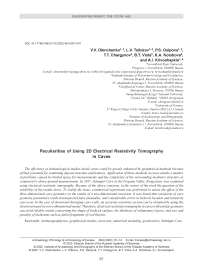Peculiarities of using 2D electrical resistivity tomography in caves
Автор: Olenchenko V.V., Tsibizov L.V., Osipova P.S., Krivoshapkin A.I., Chargynov T.T., Viola B.T., Kolobova K.A.
Журнал: Archaeology, Ethnology & Anthropology of Eurasia @journal-aeae-en
Рубрика: Paleoenvironment, the stone age
Статья в выпуске: 4 т.48, 2020 года.
Бесплатный доступ
The effi cienc y of archaeological studies inside caves could be greatly enhanced by geophysical methods because of their potential for examining deposit structure and features. Application of those methods in caves entails a number of problems caused by limited space for measurements and the complexity of the surrounding medium’s structure as compared to above-ground measurements. In 2017, Selungur Cave in the Fergana Valley, Kyrgyzstan, was examined using electrical resistivity tomography. Because of the above concerns, in the course of the work the question of the reliability of the results arose. To clarify the issue, a numerical experiment was performed to assess the effect of the three-dimensional cave geometry on the results of a two-dimensional inversion. It was found that variations of cave geometry parameters result in unexpected false anomalies, and considerable errors in bedrock location and resistivity can occur. In the case of downward diverging cave walls, an accurate resistivity section can be obtained by using the inversion based on a two-dimensional model. Therefore, electrical resistivity tomography in caves with similar geometry can yield reliable resu lts concerning the shape of bedrock surface, the thickness of sedimentary layers, and size and position of inclusions such as fallen fragments of roof therein.
Archaeogeophysics, geophysical studies, inversion, numerical modeling, geoelectrics, Selungur Cave
Короткий адрес: https://sciup.org/145146042
IDR: 145146042 | DOI: 10.17746/1563-0110.2020.48.4.067-074


